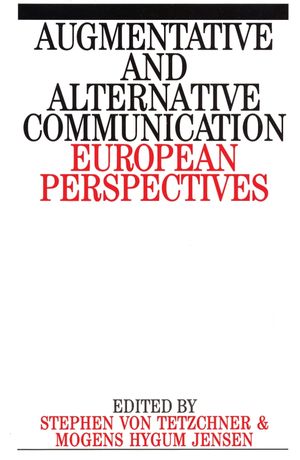Augumentative and Alternative Communication: European PerspectivesISBN: 978-1-897635-59-9
Paperback
434 pages
August 2008
 This is a Print-on-Demand title. It will be printed specifically to fill your order. Please allow an additional 10-15 days delivery time. The book is not returnable.
|
||||||
Introduction.
Chapter 1 Preliminaries to a comprehensive model of augmentative and alternative communication, Stephen von Tetzchner, Nicola Grove, Filip Loncke, Sarah Barnett, Bencie Woll and John Clibbens.
Chapter 2 Situating augmentative and alternative communication interention, Harald Martinsen and Stephen von Tetzchner.
Chapter 3 Joint attention and alterantive language intervention in autism: Implications of theory for practice, Encarnacion Sarria, Juan Carlos and Javier Tamarit.
Chapter 4 Words and strategies: Conversations with young children who use aided language, Stephen von Tetzchner and Harald Martinsen.
Chapter 5 Referring expressions in conversations between aided and natural speakers, Sarah Collins.
Chapter 6 The twopword stage in manual signs: Lanaguage development in signers with intellectual impairments, Nicola Grove, Julie Dockrell and Bencie Woll.
Chapter 7 The medium or the message: A study of speaking children using communication boards, Martine M. Smith.
Chapter 8 Sounds and silence: Interaction in aided language use, Erland Hjelmquist and Annika Dahlgren Sandberg.
Chapter 9 A psycholoinguistic approach to graphic language use, Erland Hjelmquist and Annika Dahlgren Sandberg.
Chapter 10 Being an interesting conversation partner, Norman Alm and Alan F. Newell.
Chapter 11 A Semiotic analysis of the possibilities and limitations of Blissymbols, Serenella Besio and Maria Grazia Chinato.
Chapter 12 Augmented telecommunication for people with intellectual impairment - a preview, Jane Brodin and Stephen von Tetzchner.
Chapter 13 Enhancing communication skills with children with Down syndrome: Early use of manual signs, Kaisa Launonen.
Chapter 14 Early development of symbolic communication and linguistic complexity through augmentative and alternative communication, Margriet J.M. Heim and Anne E. Baker-Mills.
Chapter 15 Allowing for developmental potential: A case study of intervention change, Susanne Moller and Stephen von Tetzchner.
Chapter 16 Supporting graphic language acquisition by a girl with multiple impairments, Carman Basil and Emili Soro-Camats.
Chapter 17 Cleaning lades an broken buses - A case study on the use of Blissymbols and traditional orthography, Manfred Gangkofer and Stephen von Tetzchner.
Chapter 18 Improving communication and language skills of children with developmental disorders: Family involvement in graphic language intervention, Lourdes Lourenco, Joaquim Faias, Rosa Afonso, Ana Moreira and Jose M. Ferreira.
Chapter 19 Collaborative problem solving in communication intervention, Eva Bjorck-Akesson, Mats Granlund and Cecilia Olsson.
Chapter 20 From system to communications: Staff training for attitude change, Elisabete Mendes and Jorge Rato.
Chapter 21 Psychological and sociological aspects of introducing augmentative an alternative communication in Hungary: Tales, facts and numbers, Sophia L. Kalman and Andras Pajor.
References and citation index.
Subject index.



